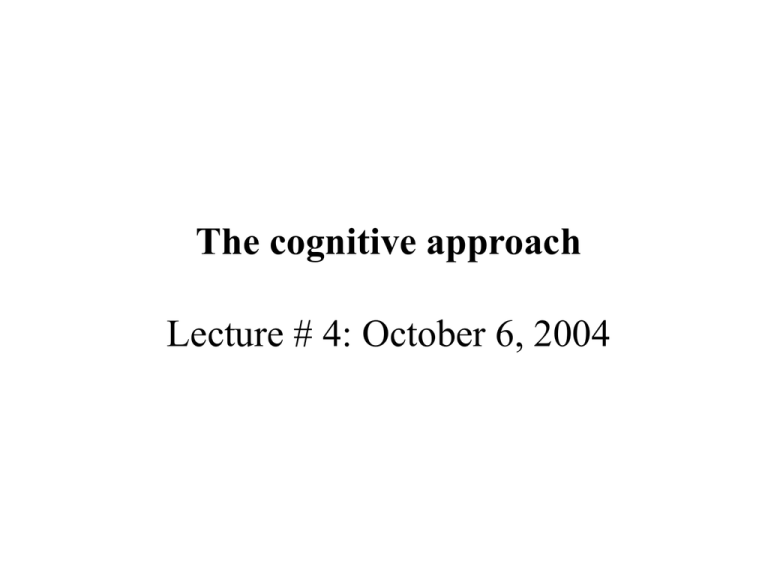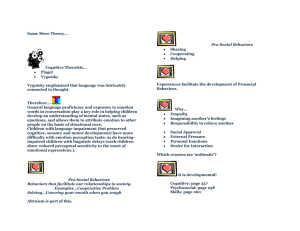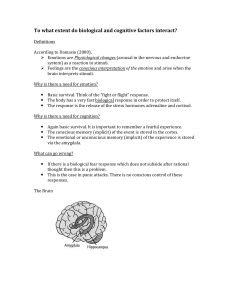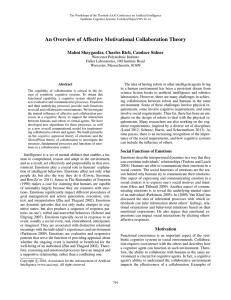PSY 394F Lecture #4 - University of Toronto
advertisement

The cognitive approach Lecture # 4: October 6, 2004 Erdmann & Van Lindern • Support for Schacter: effects seen only when a situationally appropriate cue is present • Results also support James and autonomic specificity because effects of orciprenaline were observed in self-reports of anxiety, not anger… (even though situation was anger-eliciting). – Orciprenaline has physiological effects similar to anxiety rather than anger Cognitive approach: Appraisal • Emphasizes the importance of cognition at the beginning of the sequence of events leading up to the elicitation of an emotion. • In contrast, cognitive labeling (e.g., Schacter) emphasizes the importance of cognition at the end of the sequence. • Modern appraisal research falls into one of two different categories: component approaches or goalrelevance approaches. Appraisal theories • Magda Arnold (1960)… a new view. • 1980s: A number of psychologists independently proposed detailed and ‘comprehensive’ sets of appraisal dimensions to explain the elicitation and differentiation of emotion • Methodology: Emotion episodes, verbal report Definition of appraisal • Arnold described these as: Direct, immediate, nonreflective, automatic ‘sense judgments’ about the harm or benefit that events signify for an individual, given his/her experience and aims • For Lazarus, appraisals are ‘relational meanings’ describing the implications of a particular object or situation for one’s personal well-being Richard Lazarus • Cognitive-relational-motivational theory • Primary versus secondary appraisals • Core relational theme • Know the evidence in support of the theory Lazarus vs. Zajonc • Zajonc: ‘Mere exposure effect’ • Shows that emotion can occur in the absence of cognitive processing: “Preferences need no inferences”. • Main problem involves differences in the definition of cognition. Preferences vs. basic emotions • Do you think that Lazarus and Zajonc are discussing the same basic phenomenon? – Alternative explanations for the ‘mere exposure effect’ (e.g., priming, familiarity) – Discrete basic emotions: Universal, functional • E.g., Ekman’s basic emotions Major criticisms of the appraisal approach 1) Critics challenge the claim that elaborate cognitive evaluations can be performed during the few milliseconds that seem sufficient to bring about an emotion. 2) Emotions are ‘hot’, while cognition is ‘cold’ 3) No agreement on the number or nature of appraisal dimensions that exist. What is missing? Another role for cognition? • In Oatley and Johnson-Laird’s communicative theory, a specific ‘mode’ of organization is imposed on brain function when a particular emotion is elicited • This has consequences for cognition / information processing (i.e., the effects of emotion on cognition). • Anecdote– Alone in the coffee shop at night • Reading for next week: Mathews’ (1993) paper read it in the context of functional considerations (i.e., Oatley and Johnson-Laird’s theory). Mode Theory: Oatley and Johnson-Laird’s Communicative Theory (1988; 1995) • There are a limited number of basic emotions • Each represents the solution to a particular problem of adaptation (species-specific) • These have been incorporated into our nervous systems through evolution and natural selection • Functional, adaptive… and have consequences that are superior to acting randomly, or not acting at all. • Emotions are ‘heuristics’ ‘Mode’ theory (continued) • The elicitation of emotion imposes a particular mode of organization on the nervous system, consistent with the function of that particular emotion. • This simplifies and specializes us to respond to a personally-relevant event or stimulus in our environment in an adaptive manner. • This is an example of a goal-relevance theory. Thought question • What differentiates basic emotions according to the theories that we have studied so far in this course? – – – – – Darwinian / Evolutionary James-Lange peripheral Schachter / Mandler (cognitive labeling) Cognitive: Appraisal theories Cognitive: Goal-relevance theories (e.g., Oatley and Johnson-Laird)









